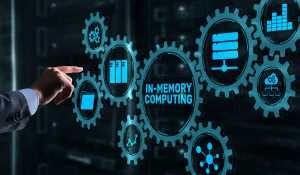
by Minsoo Rhu on Sep 9, 2021 | Tags: Datacenters, Emerging Technology, Interconnects, Memory, Memory Disaggregation, Processing-in-Memory
The Memory (Bandwidth and Capacity) Wall The “memory wall” problem, originally coined by Wulf and McKee in the 1990s, pointed out that the rate of improvement in microprocessor performance far exceeds the rate of improvement in DRAM memory speed. Such trend rendered...
Read more...

by Jonathan Baker and Fred Chong on Aug 31, 2021 | Tags: Quantum Computing
Despite quantum computing (QC) being an emerging technology, it is critical to consider new emerging technologies for this paradigm. Current machines, constructed from superconducting transmons or trapped ions, have demonstrated impressive success recently but it is...
Read more...

by Srilantha (Bobbie) Manne, Carole-Jean Wu, Parthasarathy (Partha) Ranganathan, Sarah Bird, Shane Greenstein on Aug 18, 2021 | Tags: Datacenters, Edge Devices, Emerging Technology, Environment, Inclusion, Societal Impact, Sustainability
Digital technologies have had an undeniable influence on humanity’s well-being, transforming all aspects of our lives. Underpinned by advances in process technology, computer architecture, software engineering, and artificial intelligence (AI), the rapid technological...
Read more...

by Tim Rogers and Mahmoud Khairy on Aug 10, 2021 | Tags: Accelerators, Benchmarks, Machine Learning, Systems
At its core, all engineering is science optimized (or perverted) by economics. As academics in computer science and engineering, we have a symbiotic relationship with industry. Still, it is often necessary for us to peel back the marketing noise and understand...
Read more...
by Lisa Hsu on Aug 5, 2021 | As architects, we have heard the drumbeat about the impending end of Moore’s Law for at least a few decades, and in more recent years, the end of Dennard scaling. It is this latter phenomenon that has been extremely impactful to the power consumption of the...
Read more...

by Christos Kozyrakis and Emery Berger on Jul 30, 2021 | Tags: ASPLOS, Conferences, extended abstract, program committees, Review, Reviewing
Background When we started planning the ASPLOS’21 program committee in Spring 2020, we asked ourselves what we could do to make the review process better for everyone. In our opinion, the most impactful improvement would be to increase the signal available for each...
Read more...

by Jayashree Mohan and Vijay Chidambaram on Jul 14, 2021 | Tags: Machine Learning, Storage
Machine Learning (ML), specifically Deep Neural Networks (DNNs), is stressing storage systems in new ways, moving the training bottleneck to the data ingestion phase, rather than the actual learning phase. Training these models is data-hungry, resource-intensive, and...
Read more...

by Yuhao Zhu on Jul 6, 2021 | Tags: Accelerators, deep learning, gpu, ray tracing, rendering
In Part I of this mini-series, we looked at recent advances in hardware support for ray tracing and how we might ride this wave to think more broadly about general-purpose irregular computing. Part II looks at another rising trend in graphics, i.e., the confluence of...
Read more...

by Yuhao Zhu on Jul 1, 2021 | Tags: Accelerators, gpu, graphics, ray tracing, rendering
Introduction Computer graphics exemplifies hardware-software co-design. Since its inception, rendering algorithms have been developed hand in hand with hardware architecture. Graphics is only becoming more important with the rise of new visual applications such as...
Read more...

by Adrian Sampson on Jun 29, 2021 | Tags: Accelerators, Programmability, Programming Languages
We need to make it easier to design custom, application-specific hardware accelerators. The potential efficiency gains are enormous, and the cost of deploying accelerators is falling rapidly with the widespread availability of FPGA cards and the increasing...
Read more...











